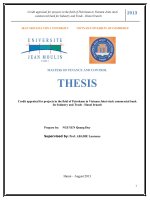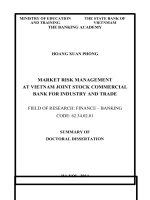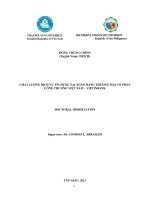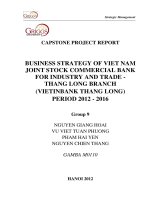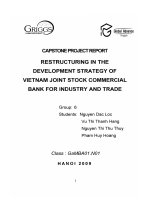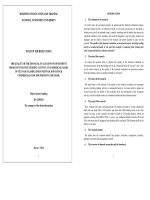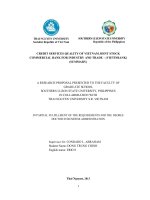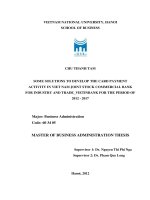Improving the performance of international payment at the Vietnam Joint Stock Commercial Bank for Industry and Trade
Bạn đang xem bản rút gọn của tài liệu. Xem và tải ngay bản đầy đủ của tài liệu tại đây (950.99 KB, 80 trang )
ACKNOWLEDGEMENT
I would like to thank several people for their help throughout graduate school
and the completion of this thesis.
First of all, I am sincerely grateful for all the help and advice I received from
my supervisor M.S Le Duc Hoang. I appreciated all the time and effort M.S Le Duc
Hoang put into helping, guiding and encouraging me during the time of making this
thesis.
I would also like to thank the lecturers and tutors in National Economics
University generally and Advanced Program particularly who have conveyed
valuable knowledge to me during the last school years.
Most of all, I sincerely thank all of the staffs in Vietnam Joint Stock
Commercial Bank for Industry and Trade (Vietinbank) who gave me favorable
conditions, helps and guidance in the days of internship at the bank.
Lastly, I would especially like to thank all my friends in Advanced Class for
all their encouragement and intellectual support that has made this report possible.
Student
Nguyen Thu Hong
Supervisor: M.S Le Duc Hoang Nguyen Thu Hong – Advanced Finance
ABBREVIATION
Abbreviation Completed script
CBs Commercial banks
E-bank Electronic bank
IP International payment
L/C Letter of credit
SBV State Bank of Vietnam
SWIFT Society for Worldwide Inter-bank Financial
Telecommunication
VietinBank
Vietnam Joint Stock Commercial Bank for Industry and
Trade
Supervisor: M.S Le Duc Hoang Nguyen Thu Hong – Advanced Finance
TABLE OF CONTENTS
ACKNOWLEDGEMENT
TABLE OF CONTENTS
ABBREVIATION
LIST OF TABLES
LIST OF DIAGRAMS
EXECUTIVE SUMMARY
INTRODUCTION
Supervisor: M.S Le Duc Hoang Nguyen Thu Hong – Advanced Finance
LIST OF TABLES
Supervisor: M.S Le Duc Hoang Nguyen Thu Hong – Advanced Finance
LIST OF DIAGRAMS
Diagram 1.1: Remittance payment process Error: Reference source not found
Diagram 1.2: Clean collection process Error: Reference source not found
Diagram 1.3: Documentary collection process Error: Reference source not found
Diagram 2.1: Organization model of VietinBank Error: Reference source not
found
Diagram 2.2: Executive apparatus of Head Office Error: Reference source not
found
Diagram 2.3: Executive apparatus of Transaction Centers, Branches Error:
Reference source not found
Diagram 2.4: Fund mobilization in VietinBank (2006-2009) Error: Reference
source not found
Diagram 2.5: Structure of funds mobilized by kinds of depositors in VietinBank
(2006-2009 26
Diagram 2.6: Loans to the economy in VietinBank (2006-2009) Error: Reference
source not found
Diagram 2.7. Investments in VietinBank (2006-2009) Error: Reference source not
found
Diagram 2.8: ATM Card and International credit card Issuance in VietinBank
(2006-2009) Error: Reference source not found
Diagram 2.9: Overseas Remittance in VietinBank (2006-2009) Error: Reference
source not found
Diagram 2.10: Correlation between Export and Import Payment activities in
VietinBank (2006-2009) Error: Reference source not found
Diagram 2.11: Total Import-Export Turnover of Vietnam (2006-2009) Error:
Reference source not found
Diagram 2.12: Export Payment activities in VietinBank (2006-2009) Error:
Reference source not found
Supervisor: M.S Le Duc Hoang Nguyen Thu Hong – Advanced Finance
Diagram 2.13: Import Payment activities in VietinBank (2006-2009) Error:
Reference source not found
Diagram 2.14: Foreign exchange fund mobilization in VietinBank Error: Reference
source not found
Diagram 2.15: Situation of foreign exchange trading in VietinBankError: Reference
source not found
Diagram 2.16: Agency relationship with foreign banks of VietinBank Error:
Reference source not found
Supervisor: M.S Le Duc Hoang Nguyen Thu Hong – Advanced Finance
EXECUTIVE SUMMARY
In the current global economy integration, an International Payment has
become an indispensable of every commercial bank. In the modern banks, revenues
from the IP activities make up more than 5% of total revenues. However, in
VietinBank, IP revenues only make up a low proportion, namely below 2% of the
total revenues of the bank. These low IP revenues are not commensurate with the
reputation, scale and ability of VietinBank.
This thesis offers appropriate solutions to improve the IP performance in
Vietinbank. The time period for this research is from 2006 to 2009. After discussing
the basic IP issues in CBs and evaluating the real situation of IP in Vietinbank, the
thesis brings out solutions to overcome the limitations and to strengthen the
effectiveness of IP business. Particularly, it is recommended that the quality of
Marketing and IP service needs improving. Besides, the capacity and qualifications
of IP staffs need enhancing, the inspection and control over IP activities need
strengthening. Finally, some recommendations are offered for the Government,
State Bank of Vietnam, and Vietnamese import-export enterprises to improve IP
performance in commercial banks generally and Vietinbank particularly.
Supervisor: M.S Le Duc Hoang Nguyen Thu Hong – Advanced Finance
INTRODUCTION
1. Rationale
After officially joining the World Trade Organization WTO (from November
7
th
, 2006), Vietnam's economy has increasingly integrated into the world economy.
That has created an equal playing field and brought about many opportunities, but
also held potential risks and great challenges to Vietnam economy. In order to
overcome the difficulties and challenges, the Vietnamese commercial banks have
actively improved their competitive advantages through measures such as: business
expansion; management capacity enhancement; financial strength and business
efficiency improvement; modernization and technological innovation Among
them, International Payment is an important link in the process of developing
international trade and also poses an urgent problem to be solved.
As one of the strongest Government commercial bank in Vietnam's banking
system, Vietnam Joint Stock Commercial Bank for Industry and Trade (Vietinbank)
has wide business network, diversified and high quality banking products, modern
computer and communication systems, and advanced banking information
processing technology Besides, Vietinbank has gained prestige from its customers
nationally and internationally, and is a member of the Society for Worldwide
Interbank Financial Telecommunication (SWIFT). International payment activities
implemented since 1990 in VietinBank has achieved certain results and met the
needs of customers for the operations relating to the payment of import and export
in a rapid, accurate, safe and effective manner.
However, international payment in VietinBank still remains many limitations
such as an imbalance between payment of import and export, complicated payment
procedures, limited operational scale Therefore, the research on international
payment activities in order to find the basic solutions for VietinBank‘s development
in the future should be considered in terms of both theory and practice. So the topic
"Improving the performance of international payment at the Vietnam Joint Stock
Commercial Bank for Industry and Trade" was chosen as the research thesis.
Supervisor: M.S Le Duc Hoang Nguyen Thu Hong – Advanced Finance
2. Research questions
This study will aim at answering three questions:
What is international payment?
What are the issues of international payment performance in Vietinbank?
What are solutions and recommendations for improving international
payment performance in Vietinbank?
3. Research objectives
- To further clarify the basic theories of economic efficiency of International
payment field, especially during the periods of globalization and international
integration.
- To assess the reality of international payment performance in Vietinbank and the
factors affecting international payment activities during the international integration
and economic development of Vietnam.
- Provides some basic solutions and recommendations to promote international
payment activities in Vietinbank.
4. Research methodology
Accessing the issues in theory and practice, this subject uses the concepts of
International payment, and then combines with statistics, analysis, synthesis, and
comparison methods in Vietinbank in order to clarify matters.
5. Research scope
- Object of research: The performance of international payment activities in
Vietinbank
- Scope of research: The real situation and performance improvements of
international payment activities in Vietinbank in recent years.
6. Research structure
Supervisor: M.S Le Duc Hoang Nguyen Thu Hong – Advanced Finance
The thesis is constituted by three parts: Introduction, Body, and Conclusion.
In which the body include three chapters:
Chapter 1: Overview of international payment performance in commercial
banks.
This chapter systematically analyzes and synthesizes the basic international
payment issues such as: IP concept, IP role, IP methods, IP international norms, and
then IP performance concept, criteria to evaluate IP performance This is an
important basis for the analysis and evaluation and solutions to improve IP
efficiency in Vietinbank.
Chapter 2: The real situation of international payment performance in
Vietnam Joint Stock Commercial Bank for Industry and Trade (Vietinbank).
This chapter analyzes and evaluates the real situation of international
payment in Vietinbank. It evaluates IP performance through some criteria and
clarifies the achievements, limitations and causes in IP activities of Vietinbank.
Chapter 3: Solutions to enhance the performance of international payment in
Vietnam Joint Stock Commercial Bank for Industry and Trade (Vietinbank).
This chapter offers solutions for Vietinbank and recommendations for the
Government, State Bank of Vietnam, Vietinbank and Vietnamese import-export
enterprises to improve IP performance in Vietinbank.
Supervisor: M.S Le Duc Hoang Nguyen Thu Hong – Advanced Finance
CHAPTER 1: OVERVIEW OF INTERNATIONAL PAYMENT
PERFORMANCE IN COMMERCIAL BANKS
1.1 International payment activities in the CBs
1.1.1 The concept of international payment
Any country who wants to develop its economy must base not only on
domestic production, but also on trade and economic relations with other countries.
Economic relations among different countries are the overall relationship of
external economics between countries. Along with the process of integration, the
external economic relations between nations has increasingly broadened, which
leads to a demand for payment between entities of these nations. Thenceforth, the
IP activities have been formed and developed; and banks are intermediate bridge
between the parties.
Thus, international payment (IP) is the implementation of the obligations to
pay and the rights to receive monetary benefit arising on the basis of economic and
non-economic activities between the organizations and individuals of this nation
and ones of the other nation, or between a nation and international organizations,
through the relationship between the banks of the nations concerned.
Under an economic point, IP consists of two areas: trade payment and non-
trade payment.
Trade payment is to make a payment for import and export goods and
services supplied for foreigners in the international market price. The basis for the
parties to conduct a purchase and make a payment to each other is foreign trade
contract, which clearly defines roles and responsibilities of each party, payment
method, payment currency, trading conditions The concerned parties will be
bound together by the signed contracts or commercial commitments.
Non-trade payment is to make a payment for the non-commercial activities
which are not related to import and export goods as well as services supplied for
foreigners. Non-trade payment is the payment for the costs of the diplomatic agency
abroad; the travel and accommodation expenses of overseas delegations,
organizations and individuals; the gifts and grants from foreign individuals to
Supervisor: M.S Le Duc Hoang Nguyen Thu Hong – Advanced Finance
1
domestic individuals; the grants from foreign charity organizations to domestic
organizations and unions.
The common means of payment: Draft, money orders, checks, debit cards
1.1.2 The role of international payment
1.1.2.1 For the economy
In the context of the increasingly internationalized world economy, IP
emerged as a bridge between the domestic economies with international economy.
IP helps promote the activities such as: import-export goods and services, foreign
investment, foreign exchange and international finance. IP activities are
increasingly appreciated in national economy in general and in foreign trading in
particular. Especially in the current context, every country gives top priority to
foreign economic activity and considers it as an inevitable path of economic
development strategies.
International payment is very important in the process of purchasing goods
and services between organizations, individuals of different nations. If IP does not
exist, the foreign economic activities are difficult to exist and develop. If IP
activities are conducted quickly, safely and accurately, the circulation of goods -
money between buyers and sellers will be processed smoothly and efficiently.
1.1.2.2 For the Commercial Banks
International payment activities have an important role in the business of a
commercial bank. High quality of IP activities is increasingly attracting customers,
creating efficiency in business as well as increasing the business scope. Besides, IP
create good conditions for banks to improve and diversify business services such as:
foreign exchange trading, underwriting business, consulting services thereby
improving the bank's reputation and confidence to customers, and increasing
competitiveness power.
In the process of implementing IP, clients who are incapable of capital will
require the financial support from the bank. The bank will provide funds to
customers in an active and positive way. Thereby, international credit, import &
export finance and fund mobilization are promoted because of taking advantage of
Supervisor: M.S Le Duc Hoang Nguyen Thu Hong – Advanced Finance
2
temporary deposits of customers participating in IP.
IP activities also help banks raise their prestige in the international arena,
thence exploit the funding from foreign banks and capital on international financial
markets.
Thanks to IP, banks can raise the efficiency of business operations. Through
IP activities, banks collected fees: underwriting fees, transfer fees, payment fees,
announcement charges that contribute to the revenue and profit of the banks.
1.1.2.3 For the enterprises with import and export business
For the import-export enterprises, IP is the last step of the foreign trade
contracts. It closes a complex and risky process of buying and selling goods and
services. Therefore, the requirements set forth for IP is to ensure the safety of
import & export contracts including the full and right receipt of goods as stated on
the contracts, profit-making business.
The implementation of IP with foreign customers creates opportunities for
Vietnamese enterprises to capture the information in the domestic market as well as
in the foreign market. Basing on market information and their economic potentials,
the enterprises can devise appropriate business strategies and solutions to prevent
risks and improve business efficiency.
1.2. International payment methods
Payment methods are indispensable parts that create foreign trade contracts
in international trade. Payment methods represent the way by which the buyer
makes payment to the seller. In international trade, either buyer or seller can choose
different payment methods that suit their business and relationship. This is one of
the factors contributing to limit risks in IP.
At present, there are 3 main payment methods including: Remittance,
Collection and Letter of Credit
Supervisor: M.S Le Duc Hoang Nguyen Thu Hong – Advanced Finance
3
1.2.1. Remittance
1.2.1.1 Concept:
Remittance is a payment method, in which the client (the remitter) requires
his bank to transfer a certain amount of money to another person (the beneficiary) at
a given address in a given time.
Remittance is simple because people who pay money and who receive
money make payments directly to each other. Banks who transfer money only act as
payment authorized intermediary for commission and they are not bound by any
liabilities to remitters or beneficiaries. Time of payment in remittance method may
be before, or after the delivery date.
There are two forms of remittance: Mail transfer and Telegraphic transfer.
Mail Transfer - M/T is the remittance form in which the remittance orders of
the Remitting bank are transferred to the Paying bank by mail.
Telegraphic transfer - T/T is the remittance form in which the remittance
orders of the Remitting bank are transferred to the Paying bank by Telex, Swift or
E-bank.
Telegraphic transfer - T/T is quick so it benefits exporters, but its cost is
high; while Mail Transfer - M/T is slow but has low cost.
The related parties in remittance include: Remitter, Beneficiary, Remitting
bank, Paying bank
1.2.1.2 Process
Diagram 1.1: Remittance payment process
Supervisor: M.S Le Duc Hoang Nguyen Thu Hong – Advanced Finance
4
Notes:
(1) Commercial Transactions (The exporter and importer sign the contract).
(2) Make a remittance order (by M/T or T/T) sending to Remitting bank
(3) Transfer money overseas to agency bank (Paying bank)
(4) Paying bank paid to the Beneficiary
1.2.1.3 Advantages and Disadvantages
a. Advantages
- For importers, the ability to get goods is high in spite of the fact that exporters do
not want to ship goods for some certain reasons. Because of paying in advance, the
importers should negotiate with exporters to be discounted.
- For exporters, because the payment is received in advance, the exporters avoid the
risk of default from the importers. The exporters can save costs of credit
management and control. The exporter's currency situation is strengthened.
b. Disadvantages
- After payment receipt, the exporters may fails to deliver, insufficiently deliver, or
even go into bankruptcy.
- After ordering, the importers do not send the payment, while the exporters
purchased inputs, so exporters may incur administrative costs, inventory costs, and
insurance premiums. Or if the goods have been sent, the exporters must wait for the
Supervisor: M.S Le Duc Hoang Nguyen Thu Hong – Advanced Finance
5
goods’ return and find other customers.
- The sellers must deliver goods after receiving confirmation of their banks for
money transfer payment which has been credited to the account of the sellers. When
the sellers have received full payment, the sellers are obliged to ensure the goods
equivalent to buyer's orders, and the sellers are also responsible for shipment and
insurance for the goods.
1.2.2. Collection
Collection is a payment method, under which the seller (exporter) after
delivering goods or providing services entrusts their bank to present the documents
through the agency bank for the buyer (importer) to be paid. The seller can accept
the draft or other conditions and terms.
Based on the characteristics of documents requested, collection method
includes two types: Clean collection and Documentary collection.
1.2.2.1. Clean collection
a. Concept
Clean collection is the method of payment, under which collection
documents include financial documents only; commercial documents are directly
sent to the importers, not through the banks.
b. Process
Diagram 1.2: Clean collection process
Supervisor: M.S Le Duc Hoang Nguyen Thu Hong – Advanced Finance
6
Notes:
(1) The
exporter and
importer sign the
contract,
including the
payment method
- "Clean
collection".
(2) The principal (the exporter) sends the goods and documents directly to the
drawee (the importer)
(3) The exporter sends the request for collection and financial documents for
Remitting bank to collect money from the importer.
(4) Remitting bank sends the collection order and financial documents to Collecting
bank to collect money from the importer.
(5) Collecting bank announces collection order and requires the import for
immediate payment or acceptance.
(6) The importer pays immediately, or accepts payment.
(7) Collecting bank sends money or bills of exchange to Remitting bank.
(8) Remitting bank sends money or bills of exchange to the exporter.
c. Advantages and Disadvantages
- Advantages: Importer guarantees his interests because they only pay for goods in hand.
- Disadvantages: The interests of the exporter cannot be guaranteed because they
have lost control of goods and payment. On the other hand, the goods receipt and
payment are not bound to each other. The importer can receive goods without
paying for it, or delay in payment. The banks only act as intermediaries. They
Supervisor: M.S Le Duc Hoang Nguyen Thu Hong – Advanced Finance
7
simply collect money to receive charges. They do not take any responsibilities if the
importer fails to pay. So the export should only use this method in cases the
exporter completely trusts the importer, the value of goods is small, goods is hard to
consume
1.2.2.2 Documentary collection
a. Concept
Documentary collection is the method of payment, under which collection
documents include commercial documents and financial documents or commercial
documents only. Collecting bank will grant collection documents to the importer
after he makes a payment or performs other obligations specified in the Collection
order.
The related parties include: The export (Drawer), the bank transferring
documents (Remitting bank), the bank collecting money (Collecting bank), and the
importer (Drawee).
b. Process
Diagram 1.3: Documentary collection process
Notes:
(1) The exporter and importer sign the contract, including the payment method -
"Documentary collection"
(2) The exporter sends the goods directly to the importer.
Supervisor: M.S Le Duc Hoang Nguyen Thu Hong – Advanced Finance
8
(3) The exporter sends collection request and documents to the Remitting bank.
(4) The Remitting bank sends collection order and documents to the Collecting bank.
(5) The Collecting bank notices collection order and present documents to the
importer.
(6) The importer accepts collection order.
(7) The Collecting bank gives the importer commercial documents.
(8) The Collecting bank sends money, accepted bills of exchange, promissory note
or debenture to the Remitting bank.
(9) The Remitting bank sends money, accepted bills of exchange, promissory note
or debenture to the exporter.
c. Advantages and Disadvantages
- Advantage: The exporter consigns his bank to not only collect money but also
control the documents to require the importer to pay or accept payment. Therefore
this method ensures more ability to collect money than remittance or clean
collection method. There has been a closely tie between the payment and the goods
receipt of the importer.
- Disadvantages: Whether the importer receives goods and makes payment or not is
still depends on the goodwill of the importer, so the interests of the exporter are not
guaranteed. Moreover, in the case of late documents, the importer cannot get goods
in time, causing big loss especially agricultural products.
1.2.3. Documentary credit
1.2.3.1. Concept
Documentary credit ensures the equality for all involved parties and ensures
the rights and obligations for both exporter and importer in the process of
implementing the contract as well as paying for goods. Therefore, the documentary
credit method is increasingly dominated and proved its effectiveness, suitability and
security in the payment process.
In Article 2, UCP 600 (The Uniform Custom and Practice for Documentary
Credits, ICC Publication No. 500, issued in 2006), Documentary Credit is defined
Supervisor: M.S Le Duc Hoang Nguyen Thu Hong – Advanced Finance
9
as follows:
Documentary credit, no matter how it is named or described, is an
agreement demonstrating a firm and irrevocable commitment of the Issuing bank
for the payment after presented accordingly.
Letter of credit (L/C) is an important tool of documentary credit payment
method. Based on common properties, letter of credit is classified into many types.
The basic types include Revocable L/C, Irrevocable L/C and Confirmed Irrevocable
L/C; the special types include Back to back L/C, Revolving L/C, Standby L/C
Related parties in the documentary credit method are very diverse, including: The
Applicant, the Beneficiary, the Issuing bank, the Advising bank, the Reimbursing
bank, the Confirming bank, the Negotiating bank, the Presenting bank…
1.2.3.2 Process
Diagram 1.4: Documentary credit payment process
Notes:
(1) The importer bases on commercial contract to send request to the Issuing bank
to open letter of credit.
(2) The Issuing bank bases on the L/C open request fully meeting the requirements
Supervisor: M.S Le Duc Hoang Nguyen Thu Hong – Advanced Finance
10
to issue L/C.
(3) The Advising bank notices and delivers L/C to the beneficiary.
(4) The export delivers goods to if he accepts the contents of the L/C.
(5) Upon completion of delivery, the exporter makes the payment documents
according to L/C, sends these documents to the Advising bank for payment.
(6) After examination of documents, the Advising bank will make the payment for
the exporter (pay immediately, or accept, or negotiate).
(7) The Advising bank transfer documents to the Issuing bank and demands money.
(8) The Issuing bank checks the documents. If they fully meet the conditions
specified in the L/C, the Issuing bank will pay.
(9) The Issuing bank notifies the current status of the documents to the importer,
asks the importer to make the payment.
(10) The importer checks documents and pays (or accepts) if they are appropriate.
The Issuing bank will not give the documents for the importer in case they do not
make the payment.
1.2.3.3 Advantages and disadvantages:
a. Advantages
- For the importer: L/C payment method can help the buyer expand the supply of
goods without wasting time and effort in finding reputable and reliable partners.
Because most of the documents are inspected by the banks and the banks will take
full responsibility for the mistakes. The buyer is assured their interests because they
buyer only make the payment after the seller delivers goods. In addition, account to
open L/C also creates interests to the importer.
- For the exporter: Seller is fully guaranteed payment with valid documents. The
payment does not depend on the importer. After delivery, the seller shall make the
documents consistent with the terms of the L/C and will be paid no matter if the
Supervisor: M.S Le Duc Hoang Nguyen Thu Hong – Advanced Finance
11
buyer cannot afford the payment. Thus, the exporter will quickly recover capital.
- For the bank: Carrying out the payment, the banks collect fees. At the same time,
banks also perform some other operations such as export loans, guarantees,
certification, and foreign currency trading Moreover, through this operation, the
prestige of the banks in international financial markets is consolidated and
expanded.
b. Disadvantages
The biggest drawback of this payment method is a very meticulous and
mechanical process. All parties are very careful in the formulation and examination
of documents. Just a small error in document formulation and examination will be a
reason to deny payment. For the Issuing bank, errors in document examination also
result in a very big loss.
Each payment method has its own advantages and disadvantages, expressed
in the conflict of interest between buyer and seller. The disadvantages can cause IP
risks.
1.3. Performance of international payment of CBs
1.3.1. The concept of IP performance of CBs
In the market economy, requirements for IP operation of CBs are efficiency
and risk minimum. An effective IP system is the foundation for the development of
the banking payment sector. High IP performance of CBs is a necessary
requirement to attract participants. IP efficiency is reflected in the payment time,
reliability and transaction costs.
- Payment time is the time since the payment order is presented until the
beneficiaries receive the full payment in the account. Length of payment time
affects production, trading and efficiency in using capital.
Supervisor: M.S Le Duc Hoang Nguyen Thu Hong – Advanced Finance
12
- Transaction costs consider the costs paid and the benefits received by the
payer. Transaction costs include costs of the transaction time and transaction
procedures The banks need to be interested in reducing transaction costs or
increasing service quality.
- Risk minimum in IP: In IP, the risks include legal risks, operational risks,
safety risks, economic risks
When studying the performance of IP in CBs, there are many diverse views
according to different research purposes. However, in this thesis, the IP
performance is studied basing on economic efficiency evaluation criteria. IP
performance represents the optimal relationship between the results obtained and
the costs to obtain such results. It is the ability to transform inputs into outputs or
reduce costs to increase revenues, profitability and competitiveness. Commercial
bank is a business unit, so the purpose of banking operations is to maximize profits
with an allowed risk level.
From the above analysis, we can generally understand that the IP
performance of CBs reflects the bank's results in IP business.
1.3.2. Basic criteria evaluating IP performance in CBs
IP performance is expressed through a system of criteria, each criterion
reflects a certain extent in the banking business and they have a certain economic
significance.
1.3.2.1. Quantitative valuation
a. Revenue valuation
- IP revenue
Basing on the IP revenue and the growth rate of IP revenue of a commercial
bank, we can see the development of the IP business in that bank. IP revenue
includes revenue from IP fees, revenue from trading foreign currencies for IP,
Supervisor: M.S Le Duc Hoang Nguyen Thu Hong – Advanced Finance
13
revenue from lending for IP A constant and steady increase of IP revenue is the
fundamental objectives of all banks. To maximize IP revenue, the bank needs to
find way to increase productivity by applying new technologies and improving IP
staffs’ skills. Besides increasing IP revenue, the bank also needs to cut down IP
operating costs to maximize IP profits.
- IP revenue / Total revenue
This indicator reflects the proportion between the revenue from IP activity
and the total revenues from other business activities of the banks. Basing on the rate
of IP revenue/Total revenue of a commercial bank, we can see the importance of the
IP business in that bank.
b. Market share valuation
Market share of a business is the market which is dominated by that
business’s products. Market share represents the quantity of a business’s products
consumed compared to total product consumed in the market. To grab market share
from the competitors, the business needs to have a suitable price policy through
price discounts needed especially when starting to penetrate new markets.
With the above concept, we found that the bank is a special type of business
with special products which are currency and services on currency. IP business is
one of the types of services provide by banks or in other words, it is the product of
the bank. Thus,”The market share of IP business in a commercial bank is a
proportion in which IP services of that bank dominate the market.”
IP market share of a commercial bank will show the fact that in an import-
export turnover of a nation, how much the rate of IP volume of that bank is.
1.3.2.2. Qualitative valuation
a. Relationship between IP activities and the growth of funds
Supervisor: M.S Le Duc Hoang Nguyen Thu Hong – Advanced Finance
14
mobilized in foreign currency
For this valuation, we should refer to the relationship between IP volume and
the balance of foreign currency deposits in banks. When conducting the IP business,
all banks must take foreign exchange income from abroad or foreign currency
expenditure for payment to abroad through NOSTRO account - an account of their
foreign currency deposits abroad. The more IP business improves, the more
transaction volume through NOSTRO accounts grows. In particular, large export
payment volume will result in high foreign exchange earnings in NOSTRO account
and large balances of foreign currency deposits at foreign banks. These are the
valuable effect of IP on banking business.
b. Relationship between IP activities and foreign exchange trading
Foreign exchange trading operations is generally executed through these
businesses: foreign exchange trading, foreign exchange conversions, foreign
currency deposits trading in nation or abroad. In the process of conducting the IP
business, banks sell foreign currency to customers wishing to pay for imports and
buy foreign currency from customers receiving payment for exports. The growth of
export and import payment services through banks will create favorable conditions
for foreign currency trading activities to raise the volume. So, thanks to IP, banks
can develop its foreign exchange trading operation and raise efficiency in the
banking business.
d. Relationship between IP activities and the development of agency
banks network
To make the foreign business operations in the areas of payment, guarantee
in a fast, safe and convenient way, the domestic banks must have the agency banks
in foreign countries. Through these businesses, the banks will create the relationship
with other domestic banks and foreign banks. And this relationship must be based
on cooperation and mutual benefits. With the long time of doing business, these
relationships are expanded and the bank's reputation in the international arena is
raised.
Supervisor: M.S Le Duc Hoang Nguyen Thu Hong – Advanced Finance
15
